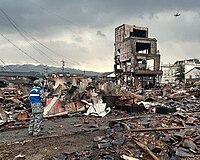
Photo from wikipedia
Gaussian processes (GPs) are becoming a standard tool to build terrain representations thanks to their capacity to model map uncertainty. This effectively yields a reliability measure of the areas of… Click to show full abstract
Gaussian processes (GPs) are becoming a standard tool to build terrain representations thanks to their capacity to model map uncertainty. This effectively yields a reliability measure of the areas of the map, which can be directly utilized by Bayes filtering algorithms in robot localization problems. A key factor is that this map uncertainty can incorporate the noise intrinsic to the terrain surveying process through the GPs ability to train on uncertain inputs (UIs). However, existing techniques to build GP maps with UIs in a tractable manner are restricted in the form and degree of the input noise. In this letter, we propose a flexible and efficient framework to build large-scale GP maps with UIs based on Stochastic Variational GPs and Monte Carlo sampling of the UIs distributions. We validate our mapping approach on a large bathymetric survey collected with an autonomous underwater vehicle (AUV) and analyze its performance against the use of deterministic inputs (DI). Finally, we show how using UI SVGP maps yields more accurate particle filter localization results than DI SVGP on a real AUV mission over an entirely predicted area.
Journal Title: IEEE Robotics and Automation Letters
Year Published: 2022
Link to full text (if available)
Share on Social Media: Sign Up to like & get
recommendations!